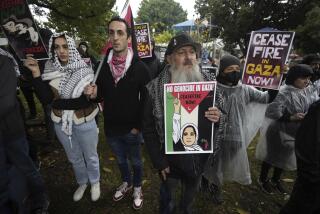Israelis Rave Against the Machine
TEL AVIV — Israel’s young people have lived with the 35-year Israeli occupation of the West Bank and Gaza for their entire lives. Now some of them are trying to dance their reality away while also protesting the occupation and what they perceive as social, economic and civil inequities within Israeli society.
They are part of Israel’s rave culture, a phenomenon that once encompassed close to 200,000 young people connected to a music and dance lifestyle that became popular in the country in the 1990s.
These raves, which feature trancelike music, sometimes included 5,000 to 10,000 participants in outside venues such as the Dead Sea area. They often danced for days (with the help of drugs, Ecstasy being the preferred substance).
They were largely influenced by the thousands of Israelis in their 20s who trekked to Goa in India and back, lured by the exotica, music, tranquillity and drugs.
Today, owing to security concerns, the rave-goers from outside Israel have disappeared along with the rest of the tourists who used to visit Israel.
“The global trance community embraces the Israel trancists and even views Israeli trance as unique, distinguished and respected,” said Bryan Meadan, who studied Israel’s rave culture at Hebrew University.
“Even in the first year of the intifada, Tel Aviv was a destination for Europeans going on club trips,” said Didi Remez, an Israeli peace activist who attends raves in Israel and Europe. “DJs from Europe would come here, like in Amsterdam and Ibiza.”
A group of twentysomethings is trying to link the raves’ appeal to political events opposing the Israeli occupation of the West Bank and Gaza Strip.
Their efforts have been applauded on several rave Web sites, which rave participants use to stay in touch across borders.
“There is a dissonance between the way we live and the way people live 5 to 10 kilometers away [the distance from Tel Aviv to the Palestinian territories], but it’s part of Israeli reality,” said Shay Rapaport, a 28-year-old Web site developer who is the main organizer. “We use the raves as a tool of protest, what can be seen as hedonism, but we have the will to live a normal life in coexistence with Arabs. We just simply want to have fun together. That’s the kind of Israel we want to see. To show this in these dark times is not cynical. It’s daring.”
Meadan stresses that this isn’t “the first time that there was an attempt to politicize the rave movement in Israel. During the 1999 elections, there was a political party running on the platform of legalizing marijuana that primarily came out of the trance cultures, and they almost got in too. The phenomenon itself will not become a political movement, but there will be a connection if they sustain momentum.”
The first Rave Against the Occupation was held in May in Tel Aviv’s Museum of Art plaza. It lasted five or six hours, not the usual 24-plus that apolitical raves last. Also, drug use was discouraged at this rave. The slogan was “Leave the territories, or don’t leave the house.”
Yet while these young people have organized to call for an end to the occupation, they are also preoccupied with what they feel is a basic unfairness in Israeli society today.
“This country is a young baby, and the values of democracy are not yet rooted deep in its society,” said Karni Cadan, one of the organizers.
Which is why, when a few thousand gathered for the first rave against the occupation, they danced to the sound of rappers such as Israeli Arab Tamar Napar, who comes from Lod, “the sewage city of Israel,” according to Cadan.
Most of the performers sang in Hebrew and Arabic. Behind the dancers and the DJs raving on the plaza, two video screens showed images from the 1967 war followed by cartoons with an antimilitarist tint.
More raves are planned.
Says Remez: “I’ve been organizing and participating in demonstrations for years, but this was the first protest activity that I felt actually expressed me. Instead of standing around passively listening to a stagnant speech for an equally stagnant politician, I could respond to biting political rap by dancing to it. I could really be part of the protest.”
More to Read
Sign up for Essential California
The most important California stories and recommendations in your inbox every morning.
You may occasionally receive promotional content from the Los Angeles Times.










